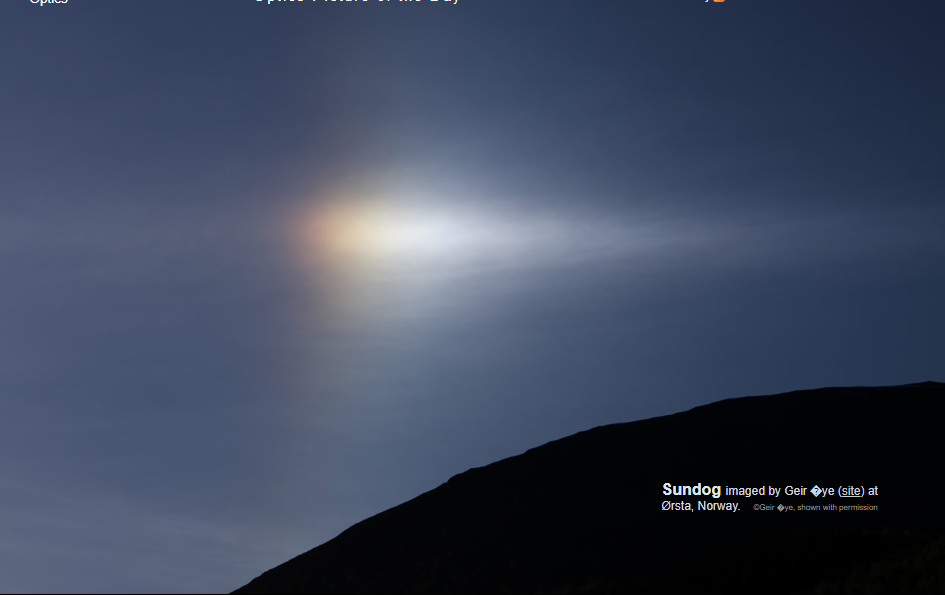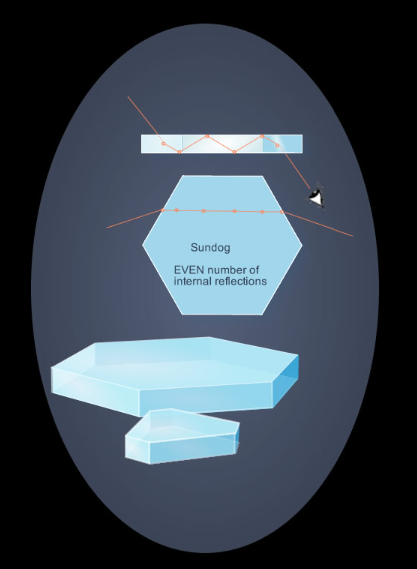OPOD - Norwegian Sundog
OPOD - Norwegian Sundog: A Captivating Atmospheric Phenomenon
Sundogs, also known as parhelia, are mesmerizing optical phenomena that occur when sunlight is refracted through hexagonal plate-shaped ice crystals. These enchanting displays can be observed in various parts of the world, including Ørsta, Norway, where Geir Øye captured a stunning image of a sundog. The photograph showcases the intricate details of this atmospheric phenomenon, revealing its ethereal beauty. In this article, we will delve deeper into the mechanics behind sundogs and explore additional elements that may accompany these captivating displays.
When sunlight passes through the hexagonal ice crystals, aerodynamic drag plays a crucial role in orienting the crystals. As a result, the large hexagonal facets of the ice crystals align almost horizontally as they gently descend in relation to the local air currents. This precise orientation contributes to the distinct shape of sundogs, with their rays entering through a vertical side face and exiting through another face inclined at approximately 60 degrees to the first.
A fascinating aspect of sundogs is the internal reflection that occurs within the ice crystals. Most sundog rays undergo multiple internal reflections from the upper and lower faces of the crystals. When there are either zero or an even number of reflections, the characteristic double sundog effect is created. This unique optical phenomenon further enhances the allure of sundogs, captivating observers with its mystical appearance.
Geir Øye's remarkable photograph not only showcases a sundog but also reveals the presence of additional atmospheric optical phenomena. Upon closer inspection, a faint trace of a parhelic circle can be observed encircling the sundog. The parhelic circle is a halo that forms around the same height as the sun and is caused by sunlight being refracted through randomly oriented ice crystals in the atmosphere. Additionally, there may be a subtle fragment of a 22-degree halo, which is another circular halo that forms at a larger radius around the sun. These accompanying optical effects add layers of complexity and intrigue to the already captivating sundog display.
To fully appreciate the beauty of sundogs and other atmospheric optical phenomena, it is important to understand the underlying scientific principles. The hexagonal shape of the ice crystals plays a crucial role in the formation of sundogs. As sunlight passes through these crystals, it undergoes refraction, bending the light rays. The precise angles at which the rays enter and exit the crystals, combined with internal reflections, contribute to the formation of sundogs and their characteristic shape.
While sundogs are a relatively common atmospheric phenomenon, their appearance can vary depending on various factors such as the size and shape of the ice crystals, the angle of the sunlight, and the observer's position. These variables contribute to the uniqueness of each sundog sighting, making them a captivating subject for photographers and sky enthusiasts alike.
In conclusion, sundogs are enchanting optical displays that occur when sunlight passes through hexagonal ice crystals. The precise orientation of the crystals, combined with internal reflections, creates the characteristic shape of sundogs. Geir Øye's photograph of a sundog in Ørsta, Norway, provides a glimpse into the ethereal beauty of this atmospheric phenomenon. Additionally, the presence of a parhelic circle and a faint fragment of a 22-degree halo adds further intrigue to the scene. Understanding the scientific principles behind sundogs allows us to appreciate their beauty and marvel at the wonders of our atmosphere. So keep your eyes to the sky and be prepared to witness the magic of sundogs whenever the conditions are just right.

Sundog imaged by Geir �ye (site) at Ørsta, Norway. ©Geir �ye, shown with permission

Sundogs are created by sunlight refracted through hexagonal plate shaped ice crystals. Aerodynamic drag orients them quite precisely with their large hexagonal facets nearly horizontal as they drift slowly downwards relative to local air currents
Sundog rays enter a vertical side face and leave through another inclined 60° to the first.
Most sundog rays are also internally reflected from the upper and lower faces. Zero or an even number of reflections create the dog.
Geir's beautiful display also has a trace of a parhelic circle and perhaps a very faint 22 degree halo fragment.
Note: this article has been automatically converted from the old site and may not appear as intended. You can find the original article here.
Reference Atmospheric Optics
If you use any of the definitions, information, or data presented on Atmospheric Optics, please copy the link or reference below to properly credit us as the reference source. Thank you!
-
<a href="https://atoptics.co.uk/blog/opod-norwegian-sundog/">OPOD - Norwegian Sundog</a>
-
"OPOD - Norwegian Sundog". Atmospheric Optics. Accessed on April 18, 2024. https://atoptics.co.uk/blog/opod-norwegian-sundog/.
-
"OPOD - Norwegian Sundog". Atmospheric Optics, https://atoptics.co.uk/blog/opod-norwegian-sundog/. Accessed 18 April, 2024
-
OPOD - Norwegian Sundog. Atmospheric Optics. Retrieved from https://atoptics.co.uk/blog/opod-norwegian-sundog/.